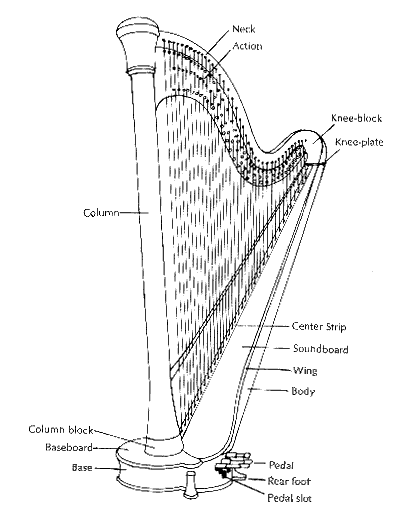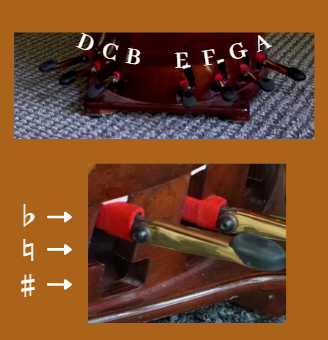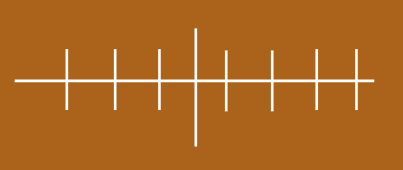The double-action pedal harp is a specific type of harp that uses pedals to change the pitch of the strings. The strings on the harp are equivalent to the white keys on the piano. A harpist has access to only seven pitches per octave. In order to access the additional chromatic pitches, a harpist must adjust the pitch using the pedals.
Other types of harps, like the lever harp and triple strung harp, provide alternate ways to access chromatic pitches. However, the pedal harp provides quick access to the maximum number of chromatic pitches without interfering with the hands. For this and other reasons, most orchestral harpists use the pedal harp.
Table of Contents
- How Many Pedals Does a Harp Have?
- How Do Harp Pedals Work?
- What are Harp Pedal Charts?
- How Quickly Can Harpists Change Pedals?
- Conclusion
- Got Questions?
How Many Pedals Does a Harp Have?
The pedal harp has seven pedals, one for each diatonic pitch class. In other words, the pedal harp has pedals for for the pitches A, B, C, D, E, F, and G. Each pedal controls all the respective pitches on the harp. For instance, the A pedal adjusts all the A strings across the pedal harp. The B pedal adjusts all the B strings, and so on.
The pedals are in this order because of the circle of 5ths. Pedals that are likely to be changed together (or in quick succession) are opposite each other. For instance:
- The middle pedals are E and B, which are the first two flats in key signatures.
- The next two pedals are F and C, which are the first two sharps in key signatures.
- The last three pedals, G, A, and D, are the the middle accidentals in both sharp and flat key signatures.
How Do Harp Pedals Work?
The pedals are connected to the harp action through pedal rods that go through the column of the harp. When the pedal is changed, the action engages or disengages the discs to adjust the tension of the string. Each string has two discs attached to it, hence the term “double action harp.”



(Photo credit: harpspectrum.org)
Each pedal can move through three positions. The top position is for flat and engages no discs. The middle position is for natural and engages one disc. The bottom position is for sharp and engages both discs. For this reason, the pedal harp is tuned to flat with all the pedals in the top position.
See below for video demonstrations:
What are Harp Pedal Charts?
Harpists use pedal charts to visualize the layout of the pedals. The harp has three pedals on the left side of the harp, which are controlled by the left foot: D-C-B (l. to r.). The harp has four pedals on the right side of the harp, which are controlled by the right foot: E-F-G-A (l. to r.). You can see this visualized on the pedal chart below.

Harpists use pedal charts in their music to keep track of the pedals. These charts are usually found at the beginning of the piece, at rehearsal numbers or at the beginning of a new section, and after long rests.
(Note that pedal charts do not dictate specific pedal changes. They are simply a reference or a “landmark”. Learn more about pedal changes here.)
How Quickly Can Harpists Change Pedals?
Skilled harpists can change pedals quite quickly, however, there are limits.
First, harpists can change pedals on opposite sides of the harp simultaneously. In other words, harpists can change a right foot pedal and a left foot pedal at the same time. The pedals F and C can be changed at the same time. However, the pedals F and G cannot be changed simultaneously.
Second, harpists can move between pedals on the same side of the harp, but more time is needed. A good general rule is to aim for no more than one pedal change on the same side of the harp, per beat.
One example of quick pedal changes is from Marcel Grandjany’s Rhapsodie. In this section, the harp has two pedal changes (on opposite sides of the harp) every beat. Since the feet are often moving between two positions of the same pedal, or adjacent pedals, this section works seamlessly.
Third, even with the pedals, harpists only have access to seven pitches per octave. The pedals can change which of those seven notes are included; however, regardless of the pedal layout and which sharps, naturals, and flats are available, the harp will still only have seven pitches (or pitch classes) available at a given time.
Finally, keep in mind the overall complexity of the music. If the notes in the hands are difficult with intricate voices, the pedals will need to be more straightforward. Conversely, if quick pedal changes are needed, simplifying the notes in the hands can make the passage more feasible.
Conclusion
The pedal harp provides the ability to quickly change key areas by using the seven pedals, one for each pitch class (or letter name). The pedals control the pitches of the strings by raising or lowering the pitch. Harpists can change pedals quickly, but planning is needed to ensure the pedals are practical.
Want to learn more? Join the Compose Harp Membership and get access to the Exploring Chromaticism Mini Course to learn how to navigate pedals when writing for the harp.
Join the conversation
Did you learn something new from this article? Do you have other questions about harp pedals? Leave a comment below!
Got Questions?
Do you have questions or other thoughts about this post? Leave a comment!
Stay Connected
Sign up for the Harp Tips Emails for more harp writing strategies and resources, plus a subscriber-exclusive Q&A.
Danielle Kuntz is a new music harpist and harp notation coach for composers. Learn more about her work at daniellekuntz.com.
